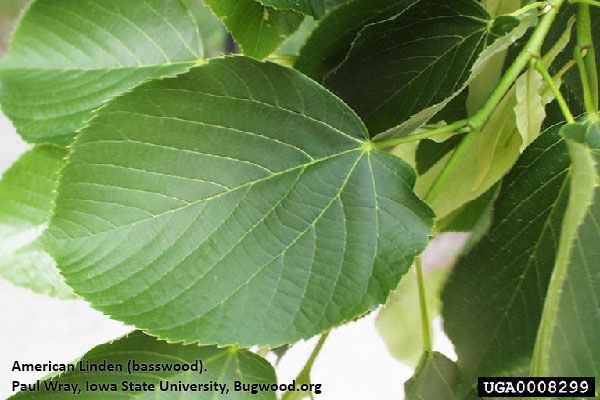June is a great month to enjoy the outdoors. Most of our plants are blooming and providing us with a great treat in our landscapes. One of my favorites for June flowers is a tree, American linden, with a very fragrant flower to enjoy from quite a distance away.
 American Linden
American LindenAmerican linden, Tilia americana, is sometimes also called basswood because Native Americans used the fibrous inner bark, called ‘bast’ to make cords and nets which led to the name of ‘bastwood’. This name was later changed to basswood. American lindens grow up to 60-80 feet tall and 30-60 feet wide. Linden has alternate leaves on a red colored stem that generally zig-zag as they grow. The leaves are 4-8 inches long and asymmetrically heart-shaped with a point on the tip. The leaves have a serrate edge and are glossy green on top, lighter green on the underside, they turn yellow in the fall. Lindens bloom in mid to late June with fragrant, pale yellow flowers that are ½ inch wide and held in a group of 5-10 flowers in a 2-3 inch cyme, or flat topped flower structure. The fruit is a hard nutlet that hangs from a long stalk with a leaf-like bract.
American linden is a great tree, and there are many cultivars to choose from for improved form, color, or growth. ‘Redmond’ is a great choice that was introduced by Plumfield Nurseries in Fremont, NE in 1927, according to Michael Dirr. This is a densely pyramidal selection with red twigs. American Sentry or ‘McKSentry’ is one with a uniform, symmetrical shape and is reported to be the most Japanese beetle resistant linden, according to Dirr. There are also other species of lindens to choose from. Tilia cordata is littleleaf linden with a smaller leaf and Tilia tomentosa is silver linden with pubescence on the underside of the leaves and on the twigs.
Lindens are a major food choice for Japanese Beetles, an invasive insect from Japan. These beetles are metallic green with copper colored elytra or hard wing covers found in beetles. Unfortunately, there are no systemic insecticides that can be used for Japanese Beetles, an arborist can treat the trees with bifenthrin or chlorantraniliprole to control large populations of the beetle when the tree is not in bloom. The lawn can also be treated with chlorantraniliprole or imidacloprid products in June to help reduce the population for next year.
According to the University of Kentucky, American linden has been cultivated in North America starting as early as 1752. The flowers are a great source for pollinators, especially honeybees. Soldier beetles are often found on this tree as well. The University of Kentucky also states that the inner bark was a significant source of fiber for ropes, cords, mats and nets used by Native Americans and early settlers. Members of the Iroquois tribe carved ceremonial masks on living trees, then cut them off and hollowed out the backs.
American linden makes a nice choice for a shade tree or specimen tree. They do, however, get very large, so pay attention to where you plant them looking above to know they will not grow into power lines or get too close to a house. If you can keep the Japanese beetles away, this tree will add value and interest to any landscape. So the next time you look for a good tree, consider American linden.

